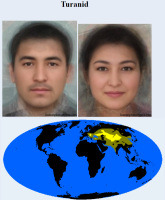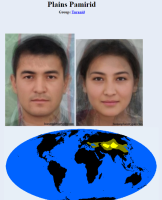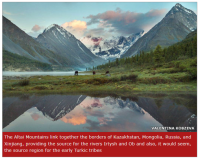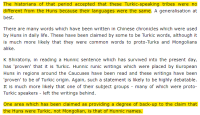Install the app
How to install the app on iOS
Follow along with the video below to see how to install our site as a web app on your home screen.
Забелешка: This feature may not be available in some browsers.
You are using an out of date browser. It may not display this or other websites correctly.
You should upgrade or use an alternative browser.
You should upgrade or use an alternative browser.
Патолошката потреба на нетуркиските источнобалкански народи по секоја цена да се идентификувaат како огурски (туркиски) Бугари
- Креатор на темата 121314
- Време на започнување

Description:
Short-headed, high-skulled type native to the steppes of Central Asia. Medium tall, often with slender bodies, an oval head and high mid face, and narrow eye lid fissure. Hairiness strong, eyebrows sometimes united. Probably originated in Altai, Tian Shan, and around the Baikal Lake. Was pushed back and replaced in many areas by the Mongol expansion. The highest concentrations today are found in Tajiks, Pamiri, Uyghurs, and Uzbeks with the Pamirids (East Pamirid, Central Pamirid, Plains Pamirid). A more robust type, possibly influenced by ancient Andronovo people, is the Andronovo-Turanid, still common in some Tatars. In Hungary, an Alföld variety is found. Some interpret the low-skulled Aralids as typical Turanids as well, they are regarded as Tungid-influenced here (following Schwidetzky, 1950).

Description:
The most Europoid Pamirid subtype. Most common in Pamiri speakers of the Pamir Mountains in Eastern Tajikistan and Northern Afghanistan, especially in the areas of Rushan, Shugan, and Vakhan. Closer to Armenoid than other Turanids. Represents a relict of an Armenoid-like group once widespread in West and Central Asia.
Physical Traits:
Light brown skin, straight or wavy, often brown hair, and mixed eyes. Medium height to rather tall, mesoskelic, ectomorph. Brachycephalic, hypsicranic. Leptorrhine, prominent, sometimes convex nose. Body hair relatively strong, eyebrows thick, sometimes united, eyes never slanting. Compared to Armenoid never prognathous, less hairy, with a lower nasal root and less convex nose.

Description:
The most typical Pamirid variety, also called Mountain Pamirid. Often considered the most typical Turanid. Most common in highland Tajiks, who not only live in Tajikistan, but also Northern Afghanistan and Eastern Uzbekistan. Shows intermediate features between the Plains Pamirid and East Pamirid. It was originally more widespread, and has been pushed back by the Tungid expansion. Sometimes in Uzbeks, Uyghurs, and other Turkic people.
Physical Traits:
Light brown skin, straight or wavy, brown-black hair. Medium height to rather tall, mesoskelic, ectomorph. Brachycephalic, mildly hypsicranic. Leptorrhine, sometimes convex nose. Head oval, mid face high, chin weakly protruding, lips thin. Eyes sometimes slanting, eyebrows thick, sometimes united, body hair modest to strong.

Description:
The most widespread Pamirid variety, typical for the steppes and lowlands from Uzbekistan to Xinjiang and the Ferghana Valley. Somewhat influenced by Aralid. Formed by contact of Turanids with Tungid-influenced groups and became widely dispersed by nomads. Most common in Uzbeks and Uyghurs, sometimes Tajiks, Kazakh, Afghans, Chinese, Anatolians, and even Hungarians.
Physical Traits:
Light brown skin, often straight, brown or black hair, eyes sometimes mixed. Medium height, brachyskelic, ecto- to endomorph. Brachycephalic, orthocranic. Mildly leptorrhine. Body hair relatively weak. Face not very flat, sometimes with the Mongolian fold.

Description:
Northern Turanid variant, has probably been more widespread prior to the Tungid expansion of Hunnic, Avar, and Chasar tribes. Influenced by the old Andronovo type, possibly even early Nordids and Pontids. May be regarded as North Pamirid. Probably common in the Neolithic Samara culture. Today most common in the Kazan Tatars, but also in other Turkic people.
Physical Traits:
Light brown skin, straight or wavy brown-black hair with dark or greenish eyes. Rather tall, mesoskelic, ectomorph to mesomorph. Mildly brachycephalic, mildly hypsicranic. Leptorrhine, sometimes convex nose. Face and angle of the mandible is wide, features robust, eyes mildly slanting, body hair relatively strong, the forehead steep.

Description:
West Tungid variety of the vast Central Asian steppes, influenced by Turanid. Developed in ancient times when Hunnic, Avar, and Chasar expansions replaced older Turanid, Mediterranid, and Nordid populations. Today most common in Kazakhs, but also in other Turkic people like Kyrgyz, Uzbeks, and Tatars. In lower frequencies in Yakuts, Nenets, Uyghurs, Mongols, and many others.
Physical Traits:
Light yellowish-brown skin, straight, sometimes wavy hair. Medium height, macroskelic, endomorph. Mildly leptorrhine, sometimes concave nose. (Hyper-)brachycephalic, chamae- orthocranic. Cheek bones very prominent, face and jaw broad, forehead slanted, eyebrows thick. Mongolian fold and facial flatness moderate.

Description:
Tungid variety, weakly influenced by Turanid. Usually united with Aralid, but more Mongoloid. Native to the Tian Shan mountains of Kyrgyzstan and Western China. Particularly common among Kyrgyz. Sporadically in Kazakhs, Yakuts, Uyghurs, Mongols, and related groups.
Physical Traits:
Light brown skin, straight, often black, sometimes light hair, and dark, sometimes mixed eyes. Medium height, macroskelic, endomorph. Mildly leptorrhine nose. Brachycephalic, chamae- orthocranic. Cheekbones very prominent, face broad, forehead often sloping. Epicanthus as strong as in Gobid, but face more profiled and body hair stronger.
Да ја разгледама десеттата хипотеза во која се тврди дека Аспаруховите Бугари биле хунско-ирански хибрид.

 iankov.blogspot.com
iankov.blogspot.com
Најпрвин да видиме кои биле Хуните.









БЪЛГАРИТЕ - КОИ СМЕ?
Најпрвин да видиме кои биле Хуните.










The Origins of the Huns
The Huns are generally thought to have been Mongolian emigrants, but here an opposing pan-Turkic viewpoint has to be refuted, argument by argument.


































